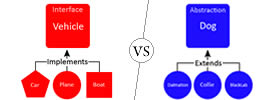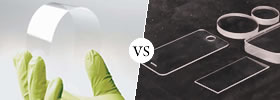Difference between Capacitor and Inductor
Key Difference: Capacitors and inductors are two passive energy storing devices. In capacitors, energy is stored in their electric field. However, in inductors energy is stored in their magnetic field.
 Capacitor is a device that is used to store an electric charge. It is basically an arrangement of conductors. Due to its characteristics, a capacitor is widely employed in the formation of electronic circuits. A capacitor stores electrical energy directly as an electrostatic field is created between two metal "plates". A capacitor is generally constructed using two metal plates or metal foils separated by an insulator called a dielectric material. Any non-conducting substance can be used as a dielectric material. However, porcelain, mylar, teflon, mica, cellulose are generally preferred. A capacitor is defined by the type of dielectric and electrode material selected. It also defines the application of the capacitor. The dielectric material is the main substance that helps in storing the electrical energy.
Capacitor is a device that is used to store an electric charge. It is basically an arrangement of conductors. Due to its characteristics, a capacitor is widely employed in the formation of electronic circuits. A capacitor stores electrical energy directly as an electrostatic field is created between two metal "plates". A capacitor is generally constructed using two metal plates or metal foils separated by an insulator called a dielectric material. Any non-conducting substance can be used as a dielectric material. However, porcelain, mylar, teflon, mica, cellulose are generally preferred. A capacitor is defined by the type of dielectric and electrode material selected. It also defines the application of the capacitor. The dielectric material is the main substance that helps in storing the electrical energy.
The value of capacitance is determined by –
The size of the plates,
The distance between them,
The type of dielectric material used.
 Inductor is a passive electronic component that can store electrical energy in the form of magnetic energy. It uses a conductor that is wound into a coil. On the flow of electricity into the coil from the left to the right, a magnetic field gets generated in the clockwise direction. Whenever voltage is applied across an inductor, a current starts to flow. The current does not rise instantly. However, it increases gradually over time. The relationship of voltage to current vs. time gives rise to a property known as inductance. The current creates a magnetic field and due to this magnetic field, electric current is stored for a short interval of time. The electric current drops when the magnetic field around the coil collapses.
Inductor is a passive electronic component that can store electrical energy in the form of magnetic energy. It uses a conductor that is wound into a coil. On the flow of electricity into the coil from the left to the right, a magnetic field gets generated in the clockwise direction. Whenever voltage is applied across an inductor, a current starts to flow. The current does not rise instantly. However, it increases gradually over time. The relationship of voltage to current vs. time gives rise to a property known as inductance. The current creates a magnetic field and due to this magnetic field, electric current is stored for a short interval of time. The electric current drops when the magnetic field around the coil collapses.
Comparison between Capacitor and Inductor:
|
|
Capacitor |
Inductor |
|
Definition |
In capacitors, energy is stored in their electric field. |
In inductors, energy is stored in their magnetic field.
|
|
Uses |
|
|
|
Unit of measurement |
Capacitance is measured in units called farads (abbreviated F). It is equal to and is equal to a [Ampere-second/Volt]. Since an [Ampere] is a [Coulomb/second], we can also say that a [F]=[C/V]. |
The value of an Inductor is called Inductance and is measured in Henries. It is actually the SI unit of Inductance. It is equal to a [Volt-second/Ampere]. |
|
Types |
Three major types of capacitors are ceramic, electrolytic, and tantalum:
|
Three major types of inductors are Coupled inductors, Multi-Layer Inductors, Ceramic Core Inductor and Molded Inductors:
|
|
Relationship between voltage and current in linear circuit |
Voltage lags behind Current by π/2
|
Current lags behind Voltage by π/2 |
|
Short circuit |
A capacitor acts as a short circuit for Alternating Current. |
An Inductor is equivalent to a short circuit to Direct Current. |
|
Characteristics |
|
|
Image Courtesy: electronics.howstuffworks.com, tradekorea.com









Comments
It was simply Awesome...<3
Maria
Thu, 02/19/2015 - 16:39
Add new comment